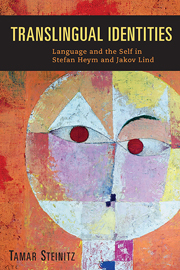Book contents
Conclusion
Published online by Cambridge University Press: 05 October 2013
Summary
The two wandering jew figures that emerge from The Inventor and The Wandering Jew articulate Lind's and Heym's respective diasporic identities, but are also extreme manifestations of their translingual process. Exile, language, and identity are intertwined in each of the translingual arcs I have charted in this study. In both cases, translingualism is a response to exile, and the course it takes as a strategy for literary creation reflects each author's way of perceiving his identity as a writer and his place in the world. Consequently, the effects of translingualism are manifested differently in each author's work.
Lind's linguistic switch is a rejection of German: a language he sees as contaminated by Nazism and that he associates not only with the historical realities of the war and the Holocaust, but also, on a more personal level, with banishment and abandonment. English, Lind's adopted language, becomes a refuge, but never a home, and translingualism becomes a form of internal exile and ultimately leads to a destructive alienation from the self. By abandoning his mother tongue, and particularly the spoken language that shaped his earliest experiences, Lind suppresses a vital part of his identity. The creation of a new self in a foreign language— a survival strategy during the war—evolves into a coping mechanism in later life, at the cost of psychic splitting and a repeated erosion of identity. As a result, the translingual self Lind presents in his autobiography—that of the cosmopolitan writer, a resolute wandering Jew—is inauthentic and represses a profound personal loss.
- Type
- Chapter
- Information
- Translingual IdentitiesLanguage and the Self in Stefan Heym and Jakov Lind, pp. 182 - 188Publisher: Boydell & BrewerPrint publication year: 2013



